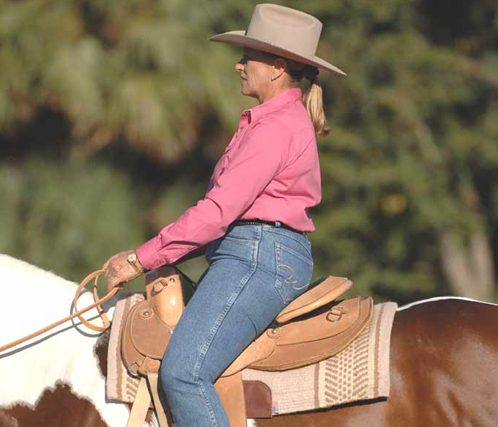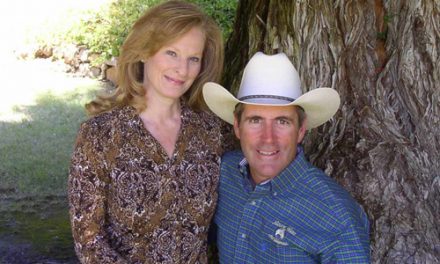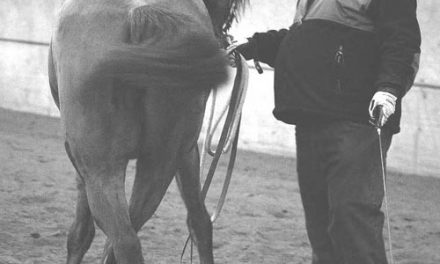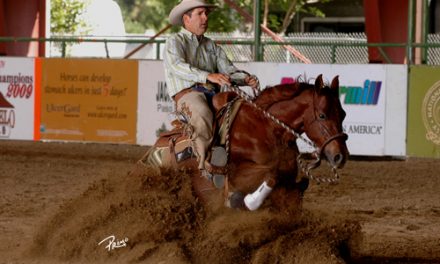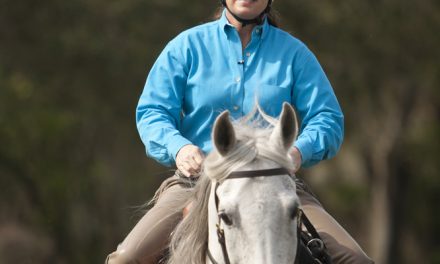Palm Partnership Training
 Now that you’ve gotten into Western Dressage, you’re eager to do well. But what are the best ways to improve your horse at his current level and move on to advance to the next level?
Now that you’ve gotten into Western Dressage, you’re eager to do well. But what are the best ways to improve your horse at his current level and move on to advance to the next level?
As you ride each day, make a plan before you get in the saddle. You are teaching your horse every time you work with him, whether you are taking an actual lesson or not. Be sure he’s learning something positive!
For starters, get your horse totally warmed up before attempting more complex maneuvers. I follow these “Golden Rules” for warm up:
1. Change directions often for lateral suppleness of your horse.
2. The working trot is the best gait for warming up. You should post to help your own body prepare and warm up.
3. Do transitions often for the longitudinal suppleness of your horse. This also helps build strength and flexibility in your horse.
4. Do some simple lateral training to loosen up your horse.
Now that you’re ready to work, here are some suggestions to help you accomplish your goals:
1. Have a plan of what you want to work on and follow it. Use the level/test you are presently working on to formulate your plan.
2. Each lesson, use a figure to work on. Practice transitions before and after the figure that are in your level/test.
3. Review the score sheet from the judge(s) at you last show and practice a tip.
4. Always work short segments. Recognize where you have a weakness in the training figure or transition. Improve your horse through your position/aids before you practice the weak areas. Remember to perfect your accuracy of the figure or transition.
5. Have someone video you as you practice so you can see if you are making progress. This allows you to recognize and review the action and timing of your aids.
6. Review your training figure and transitions. Work last on the straightness of the turn, straight line or upward or downward transition that you had in your lesson goal.
7. If you need help with a transition, use a curving line.
8. Try to improve the figure work on the size of the curve or the straight line at a different spot from where you have done your training figure.
9. Use maneuvers such as turn on the forehand, yielding at walk, turn on haunches as “cool down” maneuvers from trot and canter work.
This will keep your horse’s concentration and help him remain more interested and responding to your aids.
We all want to advance to the next level, but how do you know you’re ready? There are several ways to know:
1. Your scores improve from competition to competition.
2. Riding the test gets easier and easier.
3. Even though the hardest maneuver in the test is still challenging, all the others go well.
4. As you advance to a new test and still have one, maybe two, tasks that are challenging, when you go back to the easier test, you will find that it will improve more. The more difficult test sets your horse up to improve the easier test.
5. Ask your coach/instructor to confirm your desire to advance in your level/tests.
6. Have someone video you at a show or at home doing the whole test. Watching the test ridden in its entirety should help you realize if you’re ready to advance or not.
The best part of advancing your tests is that if you fail, or the more advanced new movements in the harder test are not going well, you can always go back to the easier test. Don’t get discouraged! I recommend giving yourself at least one to three months with a new test to decide if you are advancing at the new level, or if you need to go back to the easier one and perfect it even more.
One of the best things about dressage—whether English or Western—is that the levels and tests are the perfect progression to teach rider skills and the training/developing of your horse. If you can’t master a task, find a similar movement in the easier level/test a similar movement and work on perfecting it. This will help you advance. Everything is in print, so use the tests for your homework as you practice at home or with your instructor.
Make it a point to learn and understand how and why you are doing each component of a test. Take your time. Getting in a hurry will only set you back and cause frustration. There is no rule saying how far you have to advance; if you stay at a certain level for your riding career, that is okay.
We love to share our dressage backgrounds and knowledge with you and would love to have you come ride with us. You can join us at our farm in Ocala, Florida, or at one of our Ride Well Clinics on our USA Tour at a location near you.
If you would like to train with Lynn & Cyril at home with Western Dressage, take advantage of the following supportive training materials:
Books:
Head To Toe Horsemanship
Western Dressage—A Guide to Take You to Your First Show
A Rider Guide to Real Collection
DVDs:
“Dressage Principles for the Western Horse & Rider” Volume 1 Parts 1-5
“Dressage Principles for the Western & English Horse & Rider” Volume 2,Parts 1-3
“Let Your Horse Be Your Teacher” Parts 1&2
For more information on these training materials and more, as well as clinics, please visit www.lynnpalm.com or call us at 800-503-2824.

